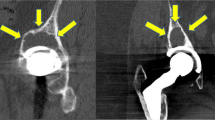Abstract
Resurfacing replacement represents the most conservative solution available for total arthroplasty of the hip. However, despite the excellent results reported by highly experienced surgeons, a small but not insignificant body of literature has been published on the more controversial aspects of this approach, mainly those related to the biological and mechanical vulnerability of the retained epiphysis. We report here our evaluation of most of the variables inherent to this procedure (surgical exposure, implant design, technical steps). Based on our results, we conclude that the short-term outcome is strongly related to the surgical approach and the relationship between implant design and cementing technique. Even if posterior approaches are currently widely accepted for resurfacing replacement, the ability to preserve the medial circumflex artery has been questioned, and an alternative exposure has been proposed with good results (antero-lateral, lateral and digastric trochanteric osteotomy). Moreover, a minimally invasive posterior approach could increase the risks of vascular damage. Alternatively, inner implant geometry could affect the distribution of cement over the epiphysis when other variables (direct or indirect cementing technique, viscosity) are not properly selected.
Résumé
Les techniques de resurfaçage sont aujourd’hui une solution conservatrice dans le cadre des prothèses totales de hanche. Cependant malgré l’excellent résultat publié par les auteurs une part non négligeable de la littérature fait état de controverses, notamment en ce qui concerne la fragilité biologique et mécanique de l’épiphyse fémorale. Les différents éléments d’appréciation de cette technique voie d’abord, dessin de l’implant, technique chirurgicale, permettent de conclure qu’à moyen terme, il existe une corrélation importante entre la voie d’abord, le dessin de l’implant et les techniques de cimentage. Même si les voies d’abord postérieures sont largement utilisées, il paraît essentiel de préserver l’artère circonflexe médiale, d’autres voies d’abord ont été proposées avec de bons résultats, voies antéro latérale, latérale, digastrique avec ostéotomie du grand trochanter. Les voies d’abord mini invasives peuvent aggraver les risques vasculaires. Le dessin de l’implant peut influencer la répartition du ciment au niveau de l’épiphyse, les autres variables notamment la technique de cimentage et la viscosité du ciment n’ont pas été évaluées.






Similar content being viewed by others
References
Allison C (2005) Minimally invasive hip resurfacing. Issues Emerg Health Technol 65:1–4
Amstutz HC, Su EP, Le Duff MJ (2005) Surface arthroplasty in young patients with hip arthritis secondary to childhood disorders. Orthop Clin North Am 36:223–230
Amstuz AC, Beaulè PE, Dorey FJ, Le Duff MJ, Campbell PA, Gruen TA (2004) Metal on metal hybrid surface arthroplasty: two to six years follow-up study. J Bone Joint Surg 86A:28–39
Amstuz HC, Campbell PA, Le Duff MJ (2004) Fracture of the neck of the femur after surface arthroplasty of the hip. J Bone Joint Surg 86A:1874–1877
Beaule PE, Campbell PA, Hoke R, Dorey F (2006) Notching of the femoral neck during resurfacing arthroplasty of the hip: a vascular study. J Bone Joint Surg Br 88:35–39
Brooker AF, Bowermann JW, Robinson RA (1973) Ectopic ossification following total hip replacement: incidence and method of classification. J Bone Joint Surg 55A:1629
Daniel J, Pynsent PB, McMinn DJ (2004) Metal-on-metal resurfacing of the hip in patients under the age of 55 years with osteoarthritis. J Bone Joint Surg Br 86:177–184
Dong T, Sun J, Qu Y, Wang Y (2005) Resurfacing arthroplasty for treatment of avascular necrosis of femoral head in young and middle-aged patient. Zhongguo Xiu Fu Chong Jian Wai Ke Za Zhi 19:707–709
Duijsens AW, Keizer S, Vliet-Vlieland T, Nelissen RG (2005) Resurfacing hip prostheses resited failure analysis during a 16-year follow-up. Int Orthop 29:224–228
Goldberg VM (2005) Surface replacement solutions for the arthritic hip. Orthopedics 28:943–944
Harris H (1969) Traumatic arthritis of the hip after dislocation and acetabular fractures: treatment by mold arthroplasty. An end-result study using a new method of result evaluation. J Bone Joint Surg 51A:737–755
Howie DW, McGee MA, Costi K, Graves SE (2005) Metal on metal resurfacing versus total hip replacement – the value of a randomized clinical trial. Orthop Clin North Am 36(2):195–201
Indelli PF, Vail TP, Dominguez D, Pickering T (2005) Resurfacing hip replacement: surgical technique and clinical results with minimum 1-year follow-up. In: 90th Natl Congr Ital Orthop Traumatol Soc, Florence, Italy
Lavigne M, Kalhor M, Beck M, Ganz R, Leunig M (2005) Distribution of vascular foramina around the femoral head and neck junction: relevance for conservative intracapsular procedures of the hip. Orthop Clin North Am 36:171–176
Little CP, Ruiz AL, Harding IJ, McLardy-Smith P, Gundle R, Murray DW, Athanasou NA (2005) Osteonecrosis in retrieved femoral heads after failed resurfacing arthroplasty of the hip. J Bone Joint Surg Br 87:320–323
Nork SE, Scar M, Pfander G, Beck M, Djonov V, Ganz R, Leunig M (2005) Anatomic considerations for choice of surgical approach for hip resurfacing arthroplasty. Orthop Clin North Am 36:163–170
Sharma H, Rana B, Watson C, Campbell AC, Singh BJ (2005) Femoral neck fractures complicating metal-on-metal resurfaced hips: a report of 2 cases. J Orthop Surg (Hong Kong) 13:69–72
Shimmin AJ, Back D (2005) Femoral neck fractures following Birmingham hip resurfacing. J Bone Joint Surg Br 87:463–464
Treacy RB, McBryde CW, Pynsent PB (2005) Birmingham hip resurfacing arthroplasty. A minimum follow-up of five years. J Bone Joint Surg Br 87:167–170
Wyness L, Vale L, McCormack K, Grant A, Brazzelli M (2004) The effectiveness of metal on metal hip resurfacing: a systematic review of the available evidence published before 2002 MC. Health Serv Res 4:39
Acknowledgements
We like express our gratitude to Dr. Chiara Pedone, Statistics, for her invaluable help with the statistical analysis of technical and clinical data.
Author information
Authors and Affiliations
Corresponding authors
Rights and permissions
About this article
Cite this article
Falez, F., Favetti, F., Casella, F. et al. Hip resurfacing: why does it fail? Early results and critical analysis of our first 60 cases. International Orthopaedics (SICO 32, 209–216 (2008). https://doi.org/10.1007/s00264-006-0313-6
Received:
Revised:
Accepted:
Published:
Issue Date:
DOI: https://doi.org/10.1007/s00264-006-0313-6




